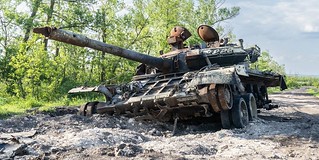The Spanish Navy's alternatives if the government does not approve the purchase of F-35 fighters
The Spanish Navy's Aircraft Flotilla (FLOAN) is in a strange and surreal situation regarding the replacement of its Harrier II.
In November 2020, the then Admiral Chief of Staff of the Navy (AJEMA) and current Chief of the Defense Staff (JEMAD), Teodoro Esteban López Calderón, indicated that he would need the F-35s "in the next 5-6 years so as not to lose the capacity that the Harrier gives us." Today, the only possible replacement for the Harrier II on the market is the F-35B, the STOVL (short takeoff and vertical landing) version of that fifth-generation American fighter.

In October 2023, the Commander of the FLOAN spoke clearly about the possible replacement of the Spanish Harrier II by F-35B: "With the Italian Marina Militare and the US Navy Marines transitioning to the F-35B, we will soon be the last and only users of the Harrier. And it is not possible to ignore that, if the Ministry of Defense decides on this purchase, there will be waiting times depending on the demand and the production capacity of the assembly lines." The commander added: "The 11 aircraft in service in the 9th Squadron is in its last third of life and its decommissioning is scheduled for around 2030."

Despite the time that has passed, the Spanish government's silence on the F-35B is absolute. It is as if this fighter has become a taboo subject, not talked about even though the Spanish Navy has no other alternative if it does not want to lose the capacity that the Harrier II currently provides. At this point, Spain seems destined to lose its fixed-wing naval combat aircraft due to an exclusively political decision, perhaps motivated by the government's insistence on finding a European alternative to the F-35B that does not exist and does not seem to exist. It seems that, if nothing is done about it, the Spanish Navy will lose that capacity. The question is: to what extent?
We must remember that the first AV-8S Harriers, nicknamed "Matador" here, arrived in Spain in 1976. A total of 15 aircraft were purchased (thirteen single-seater AV-8S and 2 two-seater TAV-8S for training). They were operational until 1996, being sold to the Thai Navy and replaced by the Harrier II.

Before the arrival of the AV-8S Harriers, the Spanish Navy operated 8 AH-1G Huey Cobra attack helicopters. The first ones were delivered to the Spanish Navy in September 1972 and operated from the "Dedalo" R-01 aircraft carrier.

The last AH-1Gs were retired in March 1987. Their record was disastrous: four of the eight helicopters were lost in accidents, killing five crew members. Part of the problems associated with the use of the AH-1G by the Spanish Navy were due to the fact that it was a single-engine model unsuitable for naval use. The US Marines have traditionally used twin-engine versions of the Huey Cobra, more suitable for the humid environments of embarked units, since there is always an active engine if one of the two fails.

A few days ago, and in view of this situation, defense analyst Salvador Mafé published a message on Twitter that may seem crazy to some, but it is not: "Nonsense: perhaps a cheaper substitute for the Harrier could be the AH-1Z Viper, faster and more agile than the Apache and which the Marines use as a CAS platform" (CAS stands for close air support).

In the comments on that thread, @MisterCromer posted this image from the dcs.com forums showing an artistic recreation of a Spanish Navy AH-64 Apache attack helicopter, in naval grey paint. It should be noted that the Apache would not be a good choice to replace the Harrier II. In 1984, McDonnell Douglas proposed a naval version of this helicopter to the US Marines, but the matter was not cancelled, since the USMC preferred the AH-1 Super Cobra. Its current version, the AH-1Z Viper, which Salvador Mafé points out, would be the most sensible option, since it is an aircraft already designed for use on aircraft carriers.

The AH-1Z is a cheaper helicopter than the AH-64 Apache and largely shares its capabilities, being able to cover close air support missions, but not with the speed of a Harrier II or an F-35B. In addition, the AH-1Z has some capacity for air-to-air combat, since it can be armed with two AIM-9 Sidewinder missiles. Obviously, it would never be a match for a fighter in an aerial combat.
Another alternative would be to replace the Harrier II with drones, which has been Turkey's resigned decision for its aircraft carriers after being excluded from the F-35 program. In any case, Spain would lose a very valuable capability and a long experience in it, and our Navy would lose the prestige of being one of the few that have carrier-based fighters. And all, I repeat, due to a political decision. It would be humiliating for the Spanish Navy to have to come to this.
---
Main photo: U.S. Marine Corps. An F-35B from the U.S. Marine Corps' VMFAT-501 squadron.
|
Don't miss the news and content that interest you. Receive the free daily newsletter in your email: |
- Most read
- Russian forces have already lost more than 10,000 armored vehicles in Ukraine
- The National Museum of Science and Technology of La Coruña and the Boeing 747 inside it
- Angel Gaitan shows the complex work of the mechanics of the Spanish EF-18 fighters
- GKFZ Kefallonia, a now abandoned NATO base on top of a Greek island
- The new Frecce Tricolori planes and their new design, a work of Pininfarina
- The firearms used by the Pontifical Swiss Guard, the smallest army in the world
- The problems of the VH-92A Patriot, the new US Marine One presidential helicopter

 ES
ES







Opina sobre esta entrada: